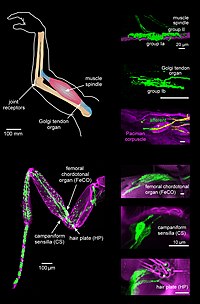
Photo from wikipedia
The human sense of touch is an integral part of daily life. For tasks involving grasping and manipulation of objects, force feedback is a key requirement. Most of the systems… Click to show full abstract
The human sense of touch is an integral part of daily life. For tasks involving grasping and manipulation of objects, force feedback is a key requirement. Most of the systems give contact point or complete grasping force feedback; for precision grasping and other physical interactions, finger awareness and force feedback from independent fingers is essential. In this study a novel, wearable proprioceptive rehabilitation system is designed which restores the ability of identifying and distinguishing between individual fingers of a prosthetic hand or an exoskeleton in a non-invasive manner. Moreover, it provides different levels of force feedback from every finger as well, which enables the user to distinguish and control force in precision grasping activities. For testing the system accuracy, classical psychophysical methods were used on a group of 14 voluntary disabled subjects. The tests were conducted in both, ideal and real-world conditions i.e. without and with distractions and accuracies were calculated accordingly. A p-test was also conducted to observe significance between the samples of with and without distraction datasets. The system performed with an overall accuracy of 82.04% which was well above the min. performance measure of 60%. Vi-HaB is standalone system and can be mounted on any upper limb rehabilitation (prosthesis, exoskeleton) system for finger awareness and force feedback.
Journal Title: IEEE Access
Year Published: 2020
Link to full text (if available)
Share on Social Media: Sign Up to like & get
recommendations!